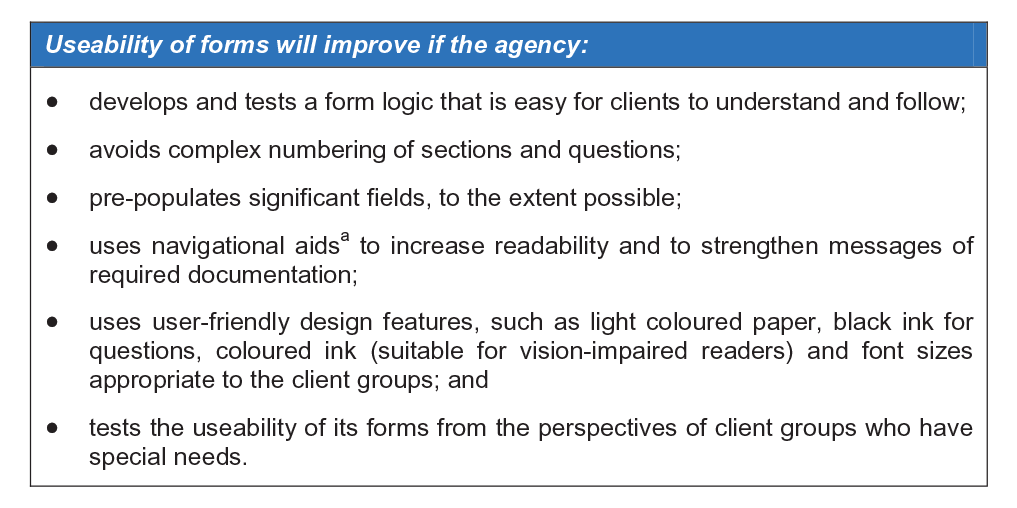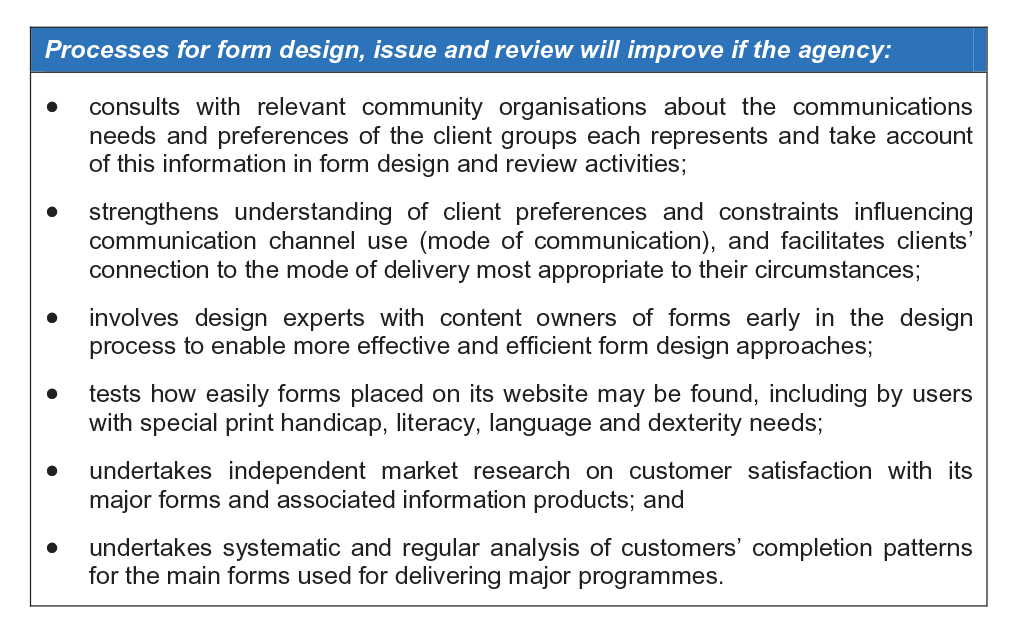Browse our range of reports and publications including performance and financial statement audit reports, assurance review reports, information reports and annual reports.
Forms for Individual Service Delivery
The ANAO conducted fieldwork in each of the audited agencies to identify the processes they used to design and review forms. The ANAO also identified the extent to which the agencies' forms are available online and their approaches to placing forms online.
Summary
Background
The Australian Government has recently increased its focus on the quality of services delivered by Australian Government agencies to members of the public. A demonstration of this was the October 2004 expansion of the Finance and Administration Portfolio to include a new Human Services Department and the transfer of several agencies, which administer, in total, more than $80 billion of expenditure for human services each year.
The first step in the provision of government services to an individual usually involves the gathering of information necessary to establish the person's identity and their eligibility for the service. Australian Government agencies typically collect this information via forms1. Accordingly, effective forms are a crucial element in the efficient and effective delivery of services to customers.
Human Services agencies issue and receive back million of forms per year, and the Minister for Human Services has recognised the importance of improving many of these forms. The Minister issued a media release on 5 September 20052 stating: ‘the six Human Service agencies are working closely to slash paperwork and produce easier-to-use forms'.
Difficult forms are likely to have an immediate, negative impact on people's perception of the quality and accessibility of an agency's services. Conversely, well-designed forms (ones with user-friendly language, are easy to handle, easy to understand and complete, and collect only necessary information) make it easier for members of the public to access government services. Well-designed forms also support administrative efficiency, because they collect comprehensive and accurate information. This reduces costly rework to fix errors caused when incomplete or inaccurate information has been provided, and reduces the likelihood of customer complaints, which can also be costly to address.
Historically, paper forms have been the basic means by which agencies have gathered information to implement government policy. However, the reliance on paper forms as the basic administrative tool for these purposes is slowly reducing. Agencies are exploring the potential for efficiencies and improved quality of customer service available from use of the telephone and/or the Internet to transact business.
Therefore, as new technologies have emerged, the business-enabling role of forms has evolved to provide more immediate and more effective communication between agencies and their customers.
Audit approach
Given the fundamental role forms play in Australian Government service delivery, the ANAO considered that it was timely to undertake an audit that examined how well key Australian Government agencies responsible for delivery of services to individuals manage form design and review. The service delivery agencies selected for audit were the three largest Human Services agencies?oCentrelink, the Child Support Agency (CSA) and Medicare Australia.
As a benchmark for comparison, the ANAO also looked at the Australian Bureau of Statistics' (ABS') use of forms in the conduct of the Household Census, the keystone of the Census of Population and Housing. The Household Census form is a significant form, which has been subject to continuous improvement over a very long period, offering potential for the identification of sound practices in form design and review.
Accordingly, the objectives of the audit were to:
- distil the practices adopted in the selected agencies which contributed to better form design and communication; and
- provide feedback to these agencies about the useability, delivery and receipt of selected forms and the effectiveness of the processes and practices underpinning them.
A key element of the audit methodology was the detailed review of the effectiveness of a sample of 11 forms currently in use in Centrelink, the CSA and Medicare Australia, as well as a Census trial form containing new questions to be included in the 2006 Census. The audit tested a range of forms, including those with high volume usage, those used by young people and specialised customer groups, those for online reporting or completed through an interactive voice recognition telephone facility, and those designed to be completed over the telephone with the assistance of a Customer Service Officer.
To examine these forms, the ANAO: arranged for professional facilitators to convene a series of focus group discussions with members of the public on the forms in the ANAO's sample; engaged specialists to review attributes of form design and accessibility; and consulted with a range of stakeholder organisations representing the interests of particular client groups.
The ANAO conducted fieldwork in each of the audited agencies to identify the processes they used to design and review forms. The ANAO also identified the extent to which the agencies' forms are available online and their approaches to placing forms online.
Overall audit conclusion
While forms issued by the selected agencies were generally user-friendly and effective in collecting the desired information, the audit identified many opportunities to improve form design, delivery and receipt, and for better processes to deliver such improvements on an ongoing basis.
Figure 1 outlines the audit's particular suggestions to improve the useability of the selected forms, particularly those issued by Human Services agencies. These suggestions are also likely to be of benefit to other agencies using forms to collect critical information from customers to enable the delivery of government services.
Figure 1 Suggestions to enhance the useability of forms

Note: (a) Examples include: coloured type directions to guide ‘skip’ instructions; questions within columns separate from instructions/other information; icons such as paperclips; and a facility for respondents to provide additional comments when completing forms.
Source: ANAO conclusion from assessing audit evidence.
There was a strong commonality between the suggestions made by the community groups to whom the ANAO spoke during this audit, the suggestions of the focus groups convened by the ANAO, and the indicators of effective form design developed by expert forms practitioners for this audit.
Figure 2 outlines the audit's particular suggestions to strengthen processes and practices for form design, issue and review.
Figure 2 Suggestions to strengthen processes and practices for form design, issue and review

Source: ANAO conclusion from assessing audit evidence.
Key observations
Key observations about form design for the selected agencies were that:
- similar to the ABS, Centrelink's selected forms were generally well-designed, with clear purpose, effective layout and logical sequencing. This enabled useability despite the forms often necessarily being long and complex;
- while the CSA concentrated on telephone-based applications, its paper forms had some design strengths but were generally less user-friendly than those of the ABS and Centrelink; and
- Medicare Australia's Medicare enrolment application form was brief and logically structured. However, the Medicare Smartcard registration form could be better designed to improve clarity, comprehension, and navigational flow.
Agencies that had sound form design processes generally produced useable forms. This enabled effective communication with their customers, and increased efficiency through reduced rework. Key observations about the form design, issue and review processes of the selected agencies were:
- similar to the ABS, Centrelink managed robust processes to understand and respond to clients' communications needs and preferences; provided appropriate channels (such as in person, by telephone, online and by post) for the delivery and receipt of forms, and made good progress towards the delivery of services online; actively managed its budgets for form design and review; had a designated Forms Officer who was responsible for coordinating and managing all aspects of forms development and production; and had detailed protocols/guidelines for form development. However, Centrelink could improve the ease by which users could find its online forms;
- the CSA also provided broadly appropriate channels for the delivery and receipt of forms; had a designated Forms Officer and appropriate protocols for forms development; but there was scope to improve research into clients' communications needs and preferences, and strengthen analysis of customers' form completion patterns to identify common areas of difficulty;
- Medicare Australia provided broadly appropriate channels for the delivery and receipt of forms but there was scope to improve research into clients' communications needs and preferences, introduce protocols for forms development, consider designating a Forms Officer, and strengthen analysis of customers' form completion patterns to identify common areas of difficulty; and
- each of the audited agencies could improve aspects of their form design and accessibility, so that clients with vision or other impairment affecting literacy can access their forms.
Recommendation
The ANAO made one recommendation for improvement in the useability of forms, particularly those issued by Human Services agencies. However, the audit recommendation and suggested approaches to form characteristics, design and review presented in the report are commended to all agencies which use forms for service delivery to individuals.
Agencies' responses
ABS response
The ABS supports Recommendation No 1 of the report. The ABS is happy with the general findings of the report. In particular, we are pleased that the report acknowledges that consideration needs to be given to the objectives of the forms being reviewed and their 'fitness for purpose', for example whether the forms are being produced for administrative purposes or for statistical purposes. The ABS is also pleased that the report has clearly indicated the development and testing work that has been undertaken in developing an electronic Census form which meets the World Wide Web Consortium (W3C) Guidelines for Accessibility Compliance Level AA and that this electronic form will increase the accessibility of the Census form for people with disabilities.
Centrelink response
Centrelink welcomes the ANAO's acknowledgement of the complexities involved in effecting timely, cost-effective and efficient interactions between government agencies and individuals in the context of a rapidly changing technological environment. Centrelink agrees with the one recommendation arising from the report “that agencies test the useability of their forms prior to their release, taking account of the literacy skills and accessibility needs of their client groups”. Centrelink will discuss this report and its recommendation with purchasing departments in the context of Centrelink's already well established processes for on-going improvement to forms design, delivery, receipt and review.
Child Support Agency response
The Child Support Agency (CSA) agrees with the ANAO's main recommendation and many of the further suggestions outlined in the report. Please note that the Parkinson report may be considered and acted on by Government over the coming months. CSA will use every opportunity to implement these recommendations when redeveloping material to accommodate new Government policy. Thank you for the opportunity to comment on your review and for helping CSA continuously improve our service delivery to our customers.
Medicare Australia response
Medicare Australia welcomes the assurance provided by the ANAO that the forms issued were generally user-friendly and effective in collecting the desired information and that Medicare Australia provided broadly appropriate channels for the delivery and receipt of forms. Medicare Australia is reviewing letters and forms to make them easier for our customers to use and understand. The ANAO recommendation will be addressed during this process. Medicare Australia agrees with the ANAO recommendation.
Footnotes
1 A form is a template containing space for the input of variable information.
2 Minister for Human Services, A New Era in Service Delivery, media release 05/100, 5 September 2005.